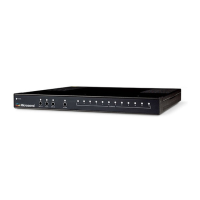Basic Operation and Features
Table 4: Auto-Switch Behavior
Autoswitch Behavior
Starting State State Change
Primary
Input Signal
Primary
External
Fault
Secondary
Input Signal
Secondary
External
Fault
Armed
Action
Alarm Comments
Selected and
Detected
Disabled or
Not Asserted
Detected Disabled or
Not Asserted
Yes None No This is the autoswitch's normal,
armed, starting state.
Selected and
Detected
(ignore) Not
Detected
(ignore) Yes Disarm Yes The primary input signal is detected
but the secondary's input signal is
not detected. Disarm because auto-
switching is no longer possible.
Selected and
Detected
(ignore) (ignore) Enabled and
Asserted
Yes Disarm Yes The primary input signal is detected
but the secondary external fault sig-
nal is enabled and asserted. Disarm
because autoswitching is no longer
possible.
Selected and
Detected
Enabled and
Asserted
Detected Disabled or
Not Asserted
Yes Automatically
switch
Yes The primary input signal is detected
but the primary external fault is ena-
bled and asserted. Perform an auto-
switch due to external fault.
Selected and
Not Detected
(ignore) Detected Disabled or
Not Asserted
Yes Automatically
switch
Yes The primary input is not detected.
Perform an autoswitch due to signal
fault.
LEDdisplay after Primary signal failure
To help in understanding normal autoswitch operation, here is an example.
In the following table, the initial conditions are that Input Bis the primary signal , Input A is the sec-
ondary signal and the autoswitch is armed.
Input B selected and armed
Input A AUTO Input B
Input A is valid
and is the sec-
ondary signal.
AUTO is armed. Input B is valid and
selected as the primary
signal.
Input B signal fails
Input A AUTO Input B
Input B has been
switched to the
outputs and is
AUTO is no longer
valid. No signal is
armed.
Input B signal has failed.
Page 14 ..........................................................................9611B_UserGuide_RevA.pdf

